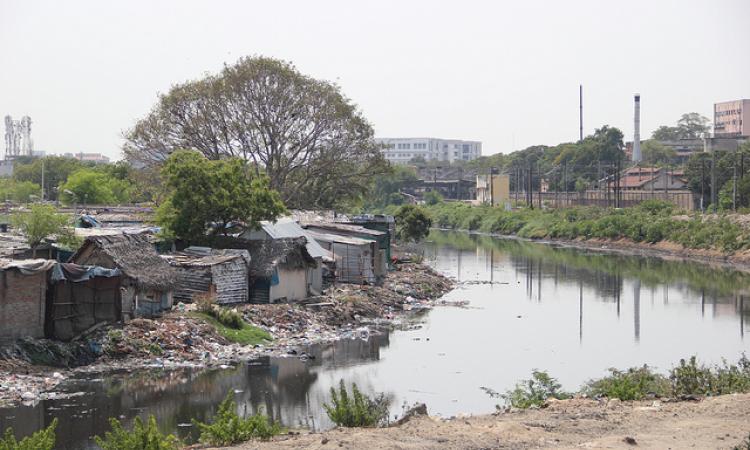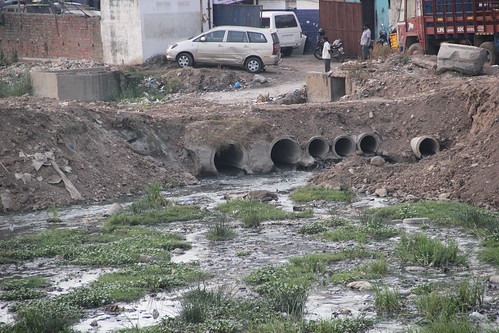
One of the shortest rivers to drain into the Bay of Bengal, the Cooum is now a local synonym for an open sewer and is generally considered to be beyond the realms of redemption. When blogger Padmapriya Baskaran, well known for her spiritual travel blog Aalayam Kanden started out on her quest to map historic temples along the river Cooum, little did she know about the treasure trove of information that lay scattered along its banks.
She was a part of a group of heritage enthusiasts who got together three years ago to delve into and profile the cultural and historical treasures along the river Palar. Since the Palar was too large a river to be dealt with by amateur researchers on weekends, they zeroed in on the Cooum for a cultural mapping project.
No river that flows through Chennai, be it the Adyar, the Cooum or the Kosasthalaiyar, is independent of the larger Palar river system. All of them are seasonal and are heavily dependent on the monsoon for their intermittent flows. While there is no denying that the ‘mother of all’, the Palar is in deep distress owing to excessive sand mining and industrial pollution, its tributaries are affected as well.
Understanding the history and geography of the Cooum
The city of Madras grew around Fort St. George located strategically at the point where the river met the sea so that both marine and inland navigation routes could be tapped to the maximum. When British administrator Francis Day and agent Andrew Cogan drew up plans to erect a trading post in the 1600s, little did they expect their establishment to eventually spur the growth of one of the strongest British settlements along the Coromandel Coast.
As the settlement grew in size so did its water requirements. The city of Madras could tap river water for municipal supply only from the northwestern route. River Adyar was practically useless for this purpose then as it flowed south of the city and was fed with the surplus from the Chembarambakkam tank. The city, therefore, was almost entirely dependent on the Kosasthalaiyar and the Cooum for its water needs before interstate water-sharing agreements were signed.
Though popular assumption holds industrial and domestic sewage responsible for killing the river completely, novelist and historian Venkatesh Ramakrishnan blames the pressures of municipal water supply for changing the river’s nature and course for good.
 “The British did not want the Cooum and the Kosasthalaiyar to flow in the first place, at least not if Madras was to develop into the huge metropolis it eventually transformed into,” notes Venkatesh. The Thamaraipakkam check dam was constructed way back in 1868 to divert the water into the Red Hills reservoir designed to provide for Madras’ drinking water needs. Water was transported via gravity through an open channel to the Cholavaram and Red Hills reservoir which eventually reached the Kilpauk water works.
“The British did not want the Cooum and the Kosasthalaiyar to flow in the first place, at least not if Madras was to develop into the huge metropolis it eventually transformed into,” notes Venkatesh. The Thamaraipakkam check dam was constructed way back in 1868 to divert the water into the Red Hills reservoir designed to provide for Madras’ drinking water needs. Water was transported via gravity through an open channel to the Cholavaram and Red Hills reservoir which eventually reached the Kilpauk water works.
Just ahead of the point where the Cooum splits from the Kosasthalaiyar to flow as a partially dependent tributary is where the Poondi reservoir stands today. A decision was made to dam the Kosasthalaiyar and retain the water in a reservoir close by. As the Cooum was to receive a sizable amount of freshwater from the Kosasthalaiyar, damming the latter meant decreased water flow to the former. Therefore, since the construction of a dam at Kesavaram in the 1940s, the Cooum’s flow has been effectively crippled due to the need for water.
“From 1941 to 1949, 4.5 lakh people migrated to Madras. The flow of both the Cooum and the Kosasthalaiyar were compromised purely to provide for Madras’ growing drinking water needs. Had the Poondi project failed, Madras’ growth story would have been completely different,” adds Venkatesh.
Scouting for heritage
While Venkatesh focused on history, compiling events that unfolded along the Cooum, Padmapriya pursued the Cooum temple trail. The team was thrilled to discover that the river had a dedicated puranam (religious text)--the Koova Puranam--which served as a starting point for locating villages and iconic temples along the river. Only those villages and temples which were within a one-kilometer radius from the river and were documented in archaeological studies and inscriptions were considered.
“We wanted our compilation to be a balanced one that could be authenticated through history, archaeology and inscription studies. That is why we did not just stick to the mythological route,” informs Priya. While the compilation of inscriptions of Madras Presidency by T. V. Mahalingam and the historical inscriptions of South India presented the much-needed direction, a host of experts from archaeology to history provided the necessary encouragement and backing from time to time. After an 18-month pilgrimage of sorts and a year of chronicling observations, The Gods of Holy Koovum was born. The book is an attempt to list out prominent temples along the Cooum complete with historical and inscriptional details of all the mentioned sites.
Farming and moksha along the Cooum
Padmapriya mentions that river water management has been amply documented in temple inscriptions all along the river. For instance, the Sivankudal temple houses 12 inscriptions about the eris or irrigation tanks that surrounded the Shiva shrine. Inscriptions at Perambakkam reveal that villagers gathered annually to pay respects to the river for a bountiful harvest. “The river and its associated landscapes were revered back then; there’s absolutely no denying that,” she adds.
Legend has it that when Lord Shiva was tasked with killing three asuras, he forgot to pay obeisance to Lord Ganesha, which eventually resulted in the toppling of his chariot as a punishment. While attempting to regain balance, the Vriddha Ksheera river gushed out from the point where Shiva placed his bow. The river which rose to wash Lord Shiva’s feet from beneath the ground came to be known as ‘Pali’, deriving its name from the Palar and later as the holy Cooum.
 Inscriptions from the times of Chola kng Rajendra II at the Thiruvirkolanathar temple in the village of Cooum reveal a great deal about resource use and allocation of land for constructing a canal to feed the Cooum tank. At the same site, another inscription of Kulothunga I dating back to 1112AD speaks of tank maintenance and upkeep. The inscription notes that paddy and fishing taxes were lifted to support repair works of the Tribhuvanamadevi Pereri, as the Cooum tank was known then.
Inscriptions from the times of Chola kng Rajendra II at the Thiruvirkolanathar temple in the village of Cooum reveal a great deal about resource use and allocation of land for constructing a canal to feed the Cooum tank. At the same site, another inscription of Kulothunga I dating back to 1112AD speaks of tank maintenance and upkeep. The inscription notes that paddy and fishing taxes were lifted to support repair works of the Tribhuvanamadevi Pereri, as the Cooum tank was known then.
The Kailasa Eswaramudaiya Mahadevar temple inscriptions in Kesavaram notes that the Cooum was placed on a par with places like Varanasi and Gaya as a moksha kshetra. Though a hard fact to digest today, bathing in the Cooum was believed to help free one from the cycle of birth and death.
Dwindling tanks and a retired river
Most villages in the Tiruvallur-Kancheepuram belt were tank-based economies, depending heavily on smaller tanks linked to the Cooum and standalone waterbodies for the sustenance of agriculture. Irrigation apart, tanks also played a crucial role in recharging groundwater. But many of these tanks are now gone, leaving no trace of the former landscape.
Padmapriya notes that many of the temple tanks have suffered a similar fate too. “The 11.2-acre temple tank at Irulancheri has dried up and is almost in ruins now. Similarly, the Oushadha Teertham of the temple at Nemam has reduced drastically in size over time. These two temple tanks are not alone; this seems to be the case in many of the Cooum sites,” she says.
Though history and culture seem to bathe the banks of the Cooum, what can now be expected from the river? Can it ever be restored back to its original glory? When asked about the possibility, Venkatesh responds with an emphatic no! He believes attempts to restore and free the river’s flow in the urban stretches is an impractical proposition. “A decision was taken to restrict the river’s flow over a century ago; how is it possible to restore a non-existent flow? The flow we see today is a combination of industrial effluents and raw domestic sewage. Plugging these inlets can, at the most, restrict this sewage flow,” he says.
Here’s hoping at least that gets done so as to rid the Cooum of the muck and stench hounding the river relentlessly for decades now.